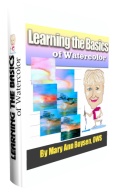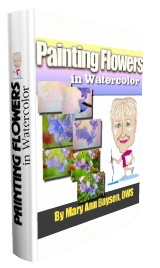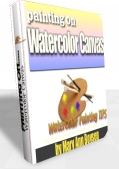For Studio Painting Taboret
This is my personal watercolor supplies checklist for my studio.
- If you're going to paint, you have to have a Palette: Personally, I use the Possum Palette See these on the Palettes page. Each color is stored in a little container with a lid so that the paint stays moist. I only open the colors that I am using at the time. The rest are undisturbed.
If want more information on available palettes I talk about them on my watercolor palettes page.
- You need a Taboret, table or drawing table, with enough room to place your paper and brushes, water, towels and other necessary supplies.
 I personally use an 8 foot table I personally use an 8 foot table  (however, just like a woman's purse, the larger the purse, the more you put in it, so my table is loaded with jars of brushes that I don’t use, books, mail and odds and ends). If you have only a small amount of space, you should have a at your side for the storage of paint tubes, brushes and the like. (however, just like a woman's purse, the larger the purse, the more you put in it, so my table is loaded with jars of brushes that I don’t use, books, mail and odds and ends). If you have only a small amount of space, you should have a at your side for the storage of paint tubes, brushes and the like.
There are many other types of work stations, depending on your space.
 You will also need an easel. So if you are just starting out make sure to get one that you can use in the studio and on the road. I like the Sidekick Easel from All Art Supplies or the Heritage Table Mount, which is mounted on the table with a clamp. It is less bulky than the wooden easel and things can easily be stored underneath. I am able to take this to lectures when I demonstrate paintings. I usually fits on any table that is available and it is (fairly) lightweight. However, it also seems to need the support of a paper towel roll to keep it from collapsing under the weight of your painting board. You will also need an easel. So if you are just starting out make sure to get one that you can use in the studio and on the road. I like the Sidekick Easel from All Art Supplies or the Heritage Table Mount, which is mounted on the table with a clamp. It is less bulky than the wooden easel and things can easily be stored underneath. I am able to take this to lectures when I demonstrate paintings. I usually fits on any table that is available and it is (fairly) lightweight. However, it also seems to need the support of a paper towel roll to keep it from collapsing under the weight of your painting board.
I like this type of easel because it is so lightweight and easy to transport. You can also place at it any angle you need to paint the way you want; sitting, standing or whatever. it's a must in my collection of watercolor supplies.- There are a number of good table top wooden easels, such as the Deluxe Table Top easel from DickBlick.
 This folds flat and can be transported without taking up too much space. This folds flat and can be transported without taking up too much space.
- A flat-file (see and entire page dedicated to them here) is an excellent way to store watercolor paper. I have several that were made by Amish carpenters. They store paper as well as prints. If you have enough drawers, you could even store a small amount of mat board for cutting mats.
- A water container: This need not be anything special. I have used just about anything that will hold water, but remember NEVER leave your brushes sitting in the water, as it will loosen the glue that holds the bristles in the ferrule of the brush. And NEVER store a wet brush with the bristles pointed UP! The water will run down through the ferrule, and then under the varnish on the handle. It will peel, loosen the ferrule, and the brush will fall in half. Bristles don’t do you much good unless they have a handle to hold them!
I use the tops of CD containers for water containers. They are plastic and clear so that I can see how dirty my water is. The colored plastic containers for my initial washes are spill proof. They use them in schools. The only drawback is that you cannot fit a large wash brush in them. And you cannot pour the color out! But they have tight fitting lids and I can keep the thinned colors for months without wasting them. I just dip a large round brush in them and put the color on my palette when I want to use it. Other good "wash" containers that do not spill when the top is on them are the kind you can purchase at the grocery store. They are about 1/2 cup in size and don't leak. Some are made by Betty Crocker and others by Zip Lock.
- Paper towels or tissue for blotting and cleaning up messes. I work very wet and find my desk needs cleaning after everyday of painting, and sometimes in between.
- Soft pencils, but not so soft that the graphite will smear in the painting process. A collection of 2-B pencils is adequate. White plastic erasers and kneaded erasers. These will not destroy the painting surface and do not leave marks on the paper.
- A board to stretch your paper on: 1/2" plywood
Or my preference, a piece of Gatorboard® or other non-absorbent surface that I can lay a soaking wet piece of paper on. The water acts like glue and the paper stays flat during the painting process without the use of tape or staples. This way, I can paint to the beautifully deckled edge of the paper and frame it by floating the paper within the mat so that the edges show. People love the look!
For Plein Air Painting
This is my watercolor supplies list when I take a trip to paint outdoors:
- In addition to all the above, an easel (instead of a table), a stool if you prefer to sit, hat, sunglasses, bug-repellent (the roll-on kind, as a spray might find its way to your painting surface, therefore repelling the paint).
- Long sleeved shirt for sun-protection, though you must NOT paint in the direct sun like many oil-painters can, as your paper must be at less of a slant, and the reflection off the paper from sun rays can be blinding.
- If you are really a serious out-door painter, you can invest in an umbrella to shield you from the sun; and maybe a few rain-drops.
- Substantial shoes for hiking to a painting location. There are wonderful supplies found on this website for plein air painting: Sun Eden
Remember, now that security is important, you should put your watercolor supplies and paints in plastic zip-lock bags, labeling them Aquarelle, Watercolor and Non flammable Then pack them in your checked luggage. You cannot take the chance that you might have to argue with some security guard who is in a bad mood and have your expensive paints confiscated.
The same goes for brushes. They can be considered weapons if the handles come to a point. There are, however, some very nice travel brushes, that have short handles, or they are built like pens with a cap that becomes the handle when removed and placed on the other end of the brush. You can carry these watercolor supplies in your carry-on bag without a problem. You can find them at DickBlick.com and Cheapjoes.com.
I use a rolling duffle bag that has two levels (found it at Costco years ago for about $40 and it has been around the world several times). In the bottom, I store my collapsible easel. I pack paper between sheets of Gatorboard, roll watercolor canvas around stretcher bars, or cut small pieces of it that can be stapled to Gatorboard for painting. If I plan to paint on the watercolor canvas, I take also a desktop stapler and box of staples.
I then pack some clothes in and around the watercolor supplies, inside the water bucket, etc. And the rest of the clothes go in the top layer of the bag.
It never fails that I get my luggage inspected, as I am sure that the easels might look like weapons, and the shapes must set off some kind of alarm. However, I have never had any watercolor supplies stolen from my bags, as I do not put anything in them that is readily re-saleable; like cameras, jewelry, etc.
Recently I was discussing international travel with some well-traveled friends and they said that they never have their bags inspected because they put their dirty underwear on top. No European security guard wants to touch it even with gloves on! Hmmm! I may have to try that on a return trip sometime!
|







 (however, just like a woman's purse, the larger the purse, the more you put in it, so my table is loaded with jars of brushes that I don’t use, books, mail and odds and ends). If you have only a small amount of space, you should have a at your side for the storage of paint tubes, brushes and the like.
(however, just like a woman's purse, the larger the purse, the more you put in it, so my table is loaded with jars of brushes that I don’t use, books, mail and odds and ends). If you have only a small amount of space, you should have a at your side for the storage of paint tubes, brushes and the like.
 This folds flat and can be transported without taking up too much space.
This folds flat and can be transported without taking up too much space.